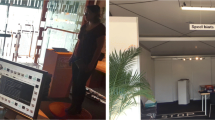Abstract
Social touch provides a rich non-verbal communication channel between humans and robots. Prior work has identified a set of touch gestures for human-robot interaction and described them with natural language labels (e.g., stroking, patting). Yet, no data exists on the semantic relationships between the touch gestures in users’ minds. To endow robots with touch intelligence, we investigated how people perceive the similarities of social touch labels from the literature. In an online study, 45 participants grouped 36 social touch labels based on their perceived similarities and annotated their groupings with descriptive names. We derived quantitative similarities of the gestures from these groupings and analyzed the similarities using hierarchical clustering. The analysis resulted in 9 clusters of touch gestures formed around the social, emotional, and contact characteristics of the gestures. We discuss the implications of our results for designing and evaluating touch sensing and interactions with social robots.
Access this chapter
Tax calculation will be finalised at checkout
Purchases are for personal use only
Similar content being viewed by others
References
Abou Chahine, R., Kwon, D., Lim, C., Park, G., Seifi, H.: Vibrotactile similarity perception in crowdsourced and lab studies. In: Seifi, H., et al. (eds.) Haptics: Science, Technology, Applications, EuroHaptics 2022. LNCS, vol. 13235, pp. 255–263. Springer, Cham (2022). https://doi.org/10.1007/978-3-031-06249-0_29
Ammi, M., et al.: Haptic human-robot affective interaction in a handshaking social protocol. In: Proceedings of the ACM/IEEE International Conference on Human-Robot Interaction (HRI), pp. 263–270 (2015)
Burns, R.B., Lee, H., Seifi, H., Faulkner, R., Kuchenbecker, K.J.: Endowing a NAO robot with practical social-touch perception. Front. Roboti. AI 86 (2022)
Burns, R.B., Seifi, H., Lee, H., Kuchenbecker, K.J.: Getting in touch with children with autism: specialist guidelines for a touch-perceiving robot. Paladyn J. Behav. Robot. 12(1), 115–135 (2021)
Choi, H., et al.: Deep learning classification of touch gestures using distributed normal and shear force. In: Proceedings of the IEEE/RSJ International Conference on Intelligent Robots and Systems (IROS), pp. 3659–3665 (2022)
Cramer, H.S., Kemper, N.A., Amin, A., Evers, V.: The effects of robot touch and proactive behaviour on perceptions of human-robot interactions. In: Proceedings of the ACM/IEEE International Conference on Human-Robot Interaction (HRI), pp. 275–276 (2009)
Fitter, N.T., Kuchenbecker, K.J.: Analyzing human high-fives to create an effective high-fiving robot. In: Proceedings of the ACM/IEEE International Conference on Human-Robot Interaction (HRI), pp. 156–157 (2014)
Hertenstein, M.J., Holmes, R., McCullough, M., Keltner, D.: The communication of emotion via touch. Emotion 9(4), 566 (2009)
Hertenstein, M.J., Keltner, D.: Gender and the communication of emotion via touch. Sex Roles 64, 70–80 (2011)
Huisman, G.: Social touch technology: a survey of haptic technology for social touch. IEEE Trans. Haptics 10(3), 391–408 (2017)
Jung, M.M., Poel, M., Poppe, R., Heylen, D.K.: Automatic recognition of touch gestures in the corpus of social touch. J. Multim. User Interfaces 11(1), 81–96 (2017)
Jung, M.M., Poppe, R., Poel, M., Heylen, D.K.: Touching the void-introducing cost: corpus of social touch. In: Proceedings of the International Conference on Multimodal Interaction (ICMI), pp. 120–127 (2014)
Li, B., et al.: Human robot activity classification based on accelerometer and gyroscope. In: Proceedings of the IEEE International Symposium on Robot and Human Interactive Communication (RO-MAN), pp. 423–424 (2016)
Murtagh, F., Contreras, P.: Algorithms for hierarchical clustering: an overview, II. Wiley Interdiscip. Rev. Data Mining Knowl. Discov. 7(6), e1219 (2017)
Pelikan, H.R., Broth, M., Keevallik, L.: Are you sad, cozmo? How humans make sense of a home robot’s emotion displays. In: Proceedings of the ACM/IEEE International Conference on Human-Robot Interaction (HRI), pp. 461–470 (2020)
Prasad, V., Koert, D., Stock-Homburg, R., Peters, J., Chalvatzaki, G.: Mild: multimodal interactive latent dynamics for learning human-robot interaction. In: Proceedings of the IEEE-RAS International Conference on Humanoid Robots (Humanoids), pp. 472–479 (2022)
Rognon, C., et al.: An online survey on the perception of mediated social touch interaction and device design. IEEE Trans. Haptics 15(2), 372–381 (2022)
Russell, J.: A circumplex model of affect. J. Personal. Soc. Psychol. 39, 1161–1178 (1980). https://doi.org/10.1037/h0077714
Salter, T., Dautenhahn, K., te Boekhorst, R.: Learning about natural human-robot interaction styles. Robot. Auton. Syst. 54(2), 127–134 (2006)
Salter, T., Michaud, F., Létourneau, D., Lee, D., Werry, I.P.: Using proprioceptive sensors for categorizing human-robot interactions. In: Proceedings of the ACM/IEEE International Conference on Human-Robot Interaction (HRI), pp. 105–112 (2007)
Seifi, H., Vasquez, S.A., Kim, H., Fazli, P.: First-hand impressions: charting and predicting user impressions of robot hands. ACM Trans. Hum. Robot Interact. (2023)
Ternes, D., MacLean, K.E.: Designing large sets of haptic icons with rhythm. In: Ferre, M. (ed.) EuroHaptics 2008. LNCS, vol. 5024, pp. 199–208. Springer, Heidelberg (2008). https://doi.org/10.1007/978-3-540-69057-3_24
Teyssier, M., Bailly, G., Pelachaud, C., Lecolinet, E.: Conveying emotions through device-initiated touch. IEEE Trans. Affect. Comput. (2020)
Teyssier, M., Parilusyan, B., Roudaut, A., Steimle, J.: Human-like artificial skin sensor for physical human-robot interaction. In: Proceedings of the IEEE International Conference on Robotics and Automation (ICRA), pp. 3626–3633. IEEE (2021)
Tsogo, L., Masson, M., Bardot, A.: Multidimensional scaling methods for many-object sets: a review. Multivar. Behav. Res. 35(3), 307–319 (2000)
Wang, Z., Giannopoulos, E., Slater, M., Peer, A.: Handshake: realistic human-robot interaction in haptic enhanced virtual reality. Presence 20(4), 371–392 (2011)
Xu, S., Xu, C., McIntyre, S., Olausson, H., Gerling, G.J.: Subtle contact nuances in the delivery of human-to-human touch distinguish emotional sentiment. IEEE Trans. Haptics 15(1), 97–102 (2021)
Yohanan, S., MacLean, K.E.: The role of affective touch in human-robot interaction: human intent and expectations in touching the haptic creature. Int. J. Soc. Robot. 4(2), 163–180 (2012)
Author information
Authors and Affiliations
Corresponding author
Editor information
Editors and Affiliations
Rights and permissions
Copyright information
© 2024 The Author(s), under exclusive license to Springer Nature Singapore Pte Ltd.
About this paper
Cite this paper
Abou Chahine, R., Vasquez, S., Fazli, P., Seifi, H. (2024). Clustering Social Touch Gestures for Human-Robot Interaction. In: Ali, A.A., et al. Social Robotics. ICSR 2023. Lecture Notes in Computer Science(), vol 14453 . Springer, Singapore. https://doi.org/10.1007/978-981-99-8715-3_6
Download citation
DOI: https://doi.org/10.1007/978-981-99-8715-3_6
Published:
Publisher Name: Springer, Singapore
Print ISBN: 978-981-99-8714-6
Online ISBN: 978-981-99-8715-3
eBook Packages: Computer ScienceComputer Science (R0)




